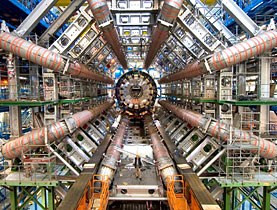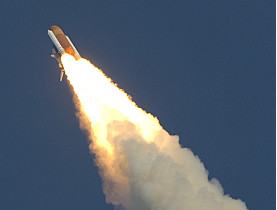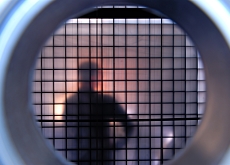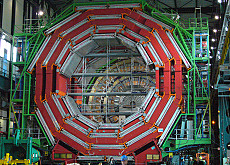Elementary fears prompt Hawaiian lawsuit

Fears of an Earth-gobbling black hole have prompted two men to take legal action against the Geneva-based European Organization for Nuclear Research (Cern).
Walter L. Wagner and Luis Sancho say the organisation’s new particle accelerator, the Large Hadron Collider (LHC), threatens the existence of the planet.
They have filed a lawsuit literally half a world away – in Hawaii.
Wagner and Sancho believe that the mammoth 27-kilometre particle accelerator could create a microscopic black hole capable of swallowing up Earth or possibly turn it into a lump of ultra-dense matter called a “strangelet”.
Apart from Cern, court documents also name three US organisations – the Department of Energy, the National Science Foundation and Fermilab, a similar laboratory and supplier to the LHC.
The suit seeks to delay the opening of the particle accelerator pending further environmental and safety reports. They also say that Cern has not complied with a United States law, the National Environmental Policy Act.
This claim is being made despite the US government not being a partner in the 20-nation intergovernmental research institution.
No black hole
Cern has dismissed the argument that the LHC – set to open in late June or early July – could lead to the end of the world.
“There is no risk that the LHC will destroy the universe,” James Gillies, the laboratory’s head of communications, told swissinfo.
“Some physicists suggest that microscopic black holes could be produced in the collisions at the LHC,” the organisation says in a statement on its website.
But it added that the collider, which was built at a cost of $8 billion (SFr7.95 billion) and is nestled some 100 metres under the ground, will produce what is “equivalent to the energies of mosquitoes”.
It also stated that it has carried out different studies on the matter, all of which indicate that the LHC will be safe.
“There is nothing new to suggest that the LHC is unsafe,” Gillies said of the lawsuit, filed 12 time zones away. He added that the organisation has published information for concerned citizens in non-technical language.
“They’ve got a lot of propaganda saying it’s safe,” Wagner told the New York Times. “But basically it’s propaganda.”
He called the latest safety review “fundamentally flawed”.
Wagner, a US citizen and a botanist, is also a lawyer and a one-time nuclear safety officer. Sancho, a Spanish citizen, is a self-described “author and researcher on time theory”, according to the Times.
Double-checking
To be on the safe side, Cern had commissioned an additional internal study, this one anonymous, which was concluded in January.
“The possibility that a black hole eats up the Earth is too serious a threat to leave it as a matter of argument among crackpots,” physicist Michelangelo Mangano, a member of the Safety Assessment Group, said.
The LHC is set to begin smashing its first protons together later in 2008. Travelling at close to the speed of light, scientists say it will create conditions resembling those at the beginnings of the universe.
Cern finds the link between its work and a US court tenuous.
“It’s hard to see how a district court in Hawaii has jurisdiction over an intergovernmental organisation in Europe,” Gillies pointed out.
At least one defendant – the US government – has said that it will be in court.
It will dispatch lawyers from the Department of Justice around the middle of June for an initial conference.
But barring a dramatic reversal of fortune, Wagner will not have the opportunity to face down Cern – ostensibly the suit’s main target – in court.
Gillies says his organisation had received no court documents, not that they would make any difference.
“Realistically, there is no chance we would show up,” he said.
swissinfo, Justin Häne
In the LHC, high-energy protons in two counter-rotating beams will be smashed together to search for exotic particles.
The beams contain billions of protons. Travelling just under the speed of light, they are guided by thousands of superconducting magnets.
The beams usually move through two vacuum pipes, but at four points they collide in the hearts of the main experiments, known by their acronyms: ALICE, ATLAS, CMS, and LHCb.
The detectors could see up to 600 million collision events per second, with the experiments scouring the data for signs of extremely rare events such as the creation of the so-called God particle, the yet-to-be discovered Higgs boson.
The LHC tunnel is 27 km long and runs between Lake Geneva and the Jura mountain range. When it was excavated, its two ends met up within 1 cm.
Cables for the LHC contain 6,300 “superconducting filaments of niobium-titanium” that are 0.006 mm thick. In total, they stretch more than 10 times the Earth’s distance to the sun.
The LHC contains the world’s largest fridge. Its temperature is colder than deep space.
The LHC’s two proton beams will use as much energy as a 400-metric ton train travelling at 200 km/h.
The system’s magnet contains more iron than the Eiffel Tower.
Data recorded by the LRC will be enough to fill 100,000 DVDs each year.

In compliance with the JTI standards
More: SWI swissinfo.ch certified by the Journalism Trust Initiative



You can find an overview of ongoing debates with our journalists here. Please join us!
If you want to start a conversation about a topic raised in this article or want to report factual errors, email us at english@swissinfo.ch.